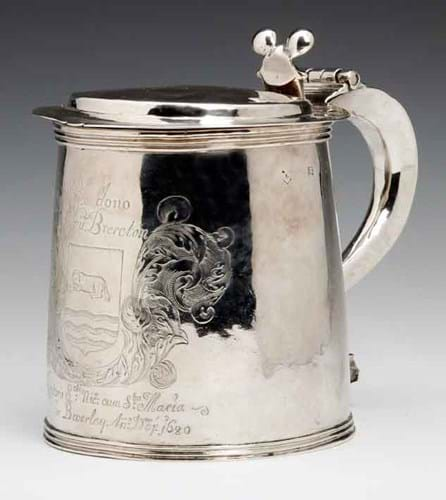It was commissioned by the Rector of St Mary's Church in Beverley, Yorkshire from the Hull smith Edward Mangie, only four of whose tankards were known to exist (two are in the Hull Museum) until this example was consigned for sale by the parish.
Offered among the silver on the first day of the June 12-14 auction, the 6¾in (17cm) tall, 25oz tankard is engraved with a coat of arms and inscribed Ex dono, John Brereton, Rectoris Scti; Nic: cum Sta. Maria, in Beverley Ano Doj 1680.
When it was commissioned, Edward Mangie (1634-85) was already one of the two most successful smiths in nearby Hull, having bought his Freedom in 1659 and produced ecclesiastical and domestic pieces as well as ceremonial maces for the Hull and Grimsby corporations.
After his death, his wife Katherine continued the business, which survived the closure of the provincial assay offices in 1695 and was still going, at least as a retailer, under their son Edward Mangie until his death in 1739.
Silver History
Hull silver in general is sought by collectors. Silversmiths are known to have been working in the city in the early 15th century but the Company of Goldsmith and Smiths was not formed until 1598 and production ceased in the early 18th century.
There was no official assay office in the town and, after being marked with a capital H plus makers' initials in the early years, silver was then struck with three crowns, the town's arms.
The history of the clergyman who commissioned the tankard also lent some extra interest in the tankard.
John Brereton, a Puritan Anglican, had fallen out with his Catholic-leaning family of Cheshire aristocrats and lost much of his expected inheritance.
Nevertheless, he appears to have had more wealth than the annual £50 stipend as rector of St Mary's and in the 1680s gifted plate and other pieces to the Corporation of Beverley as well as the church. His money must have run out for in 1689 he was found to have 'appropriated' church collection money, and possibly its plate, along with money collected in the town for the relief of French Protestants and Brereton was forced to resign.
The tankard, however, remained with the church and at Bonhams, where it was estimated at £10,000-15,000, it sold at £17,000 to a North West private buyer.
The buyer's premium was 25%





